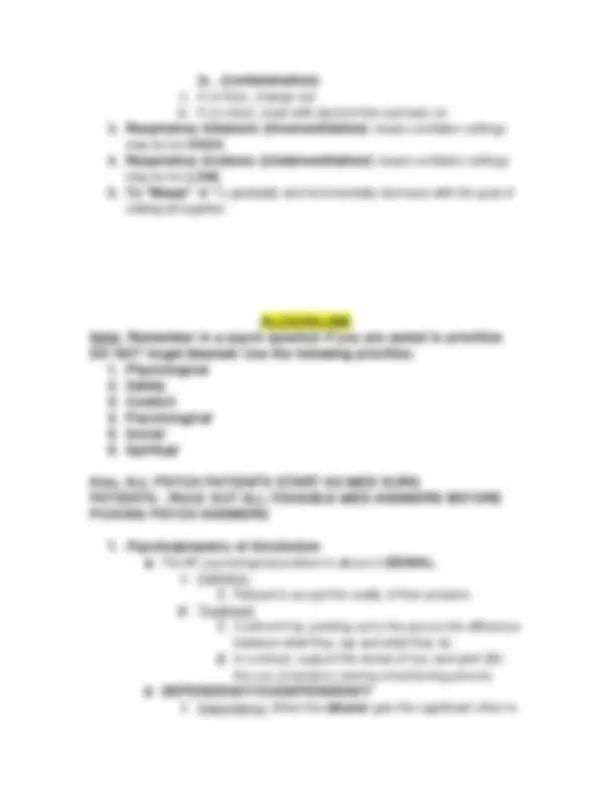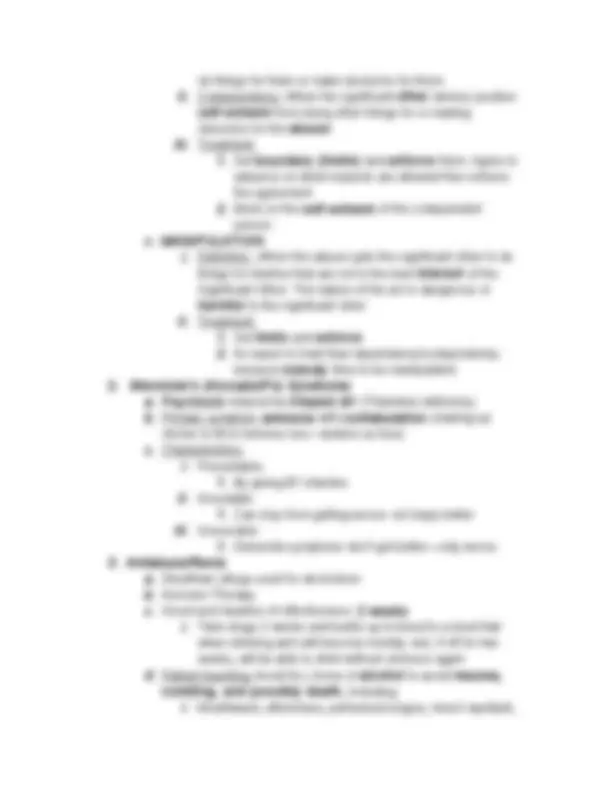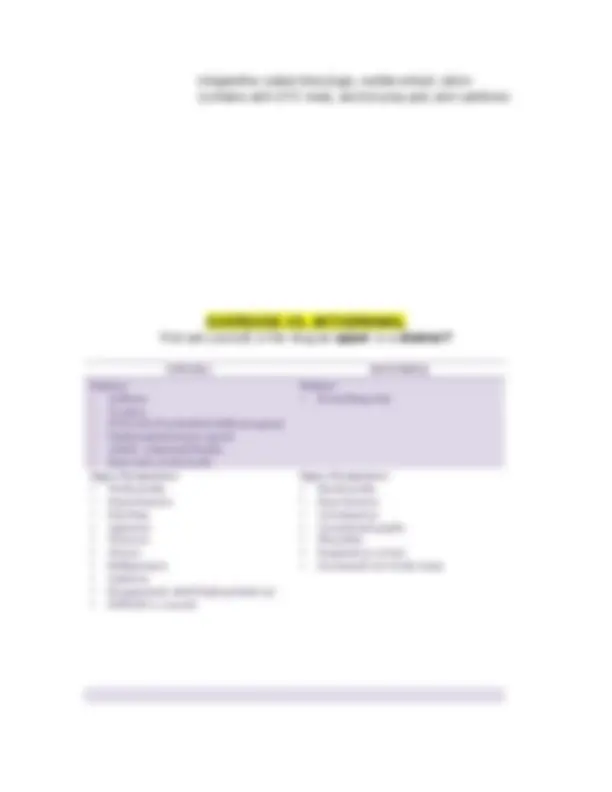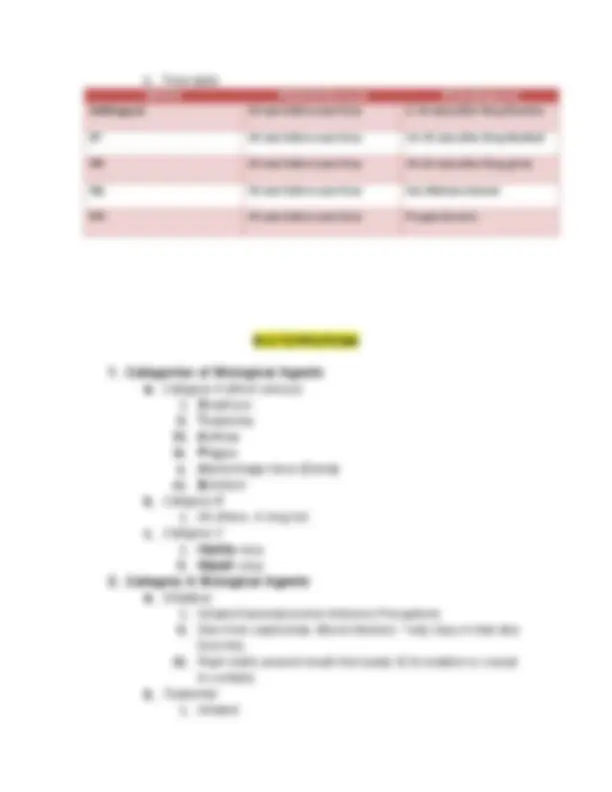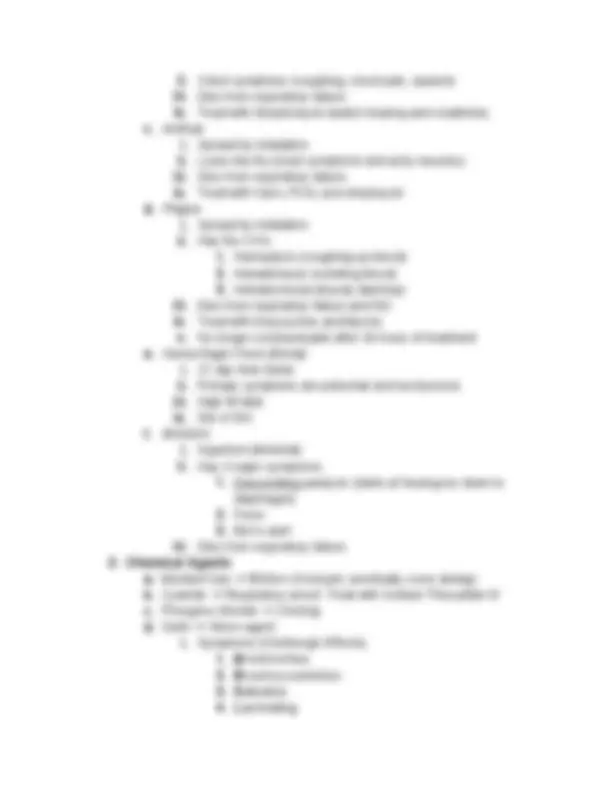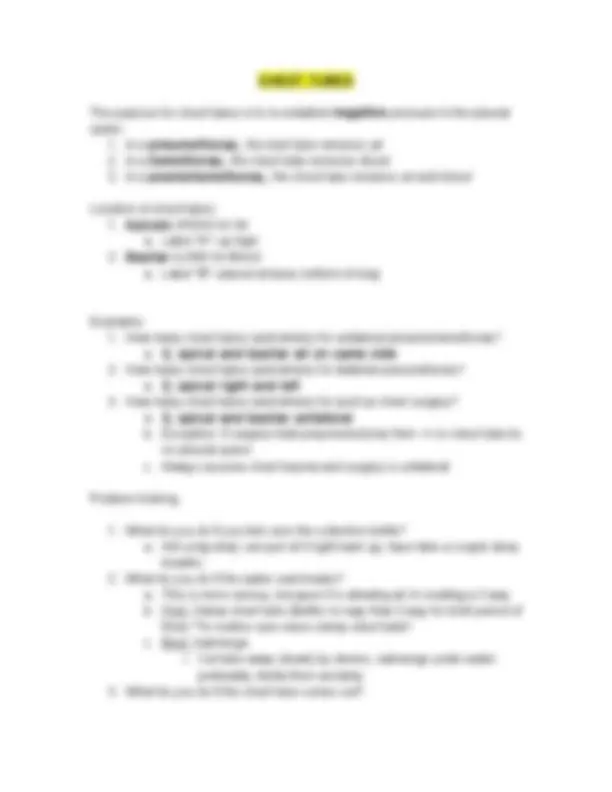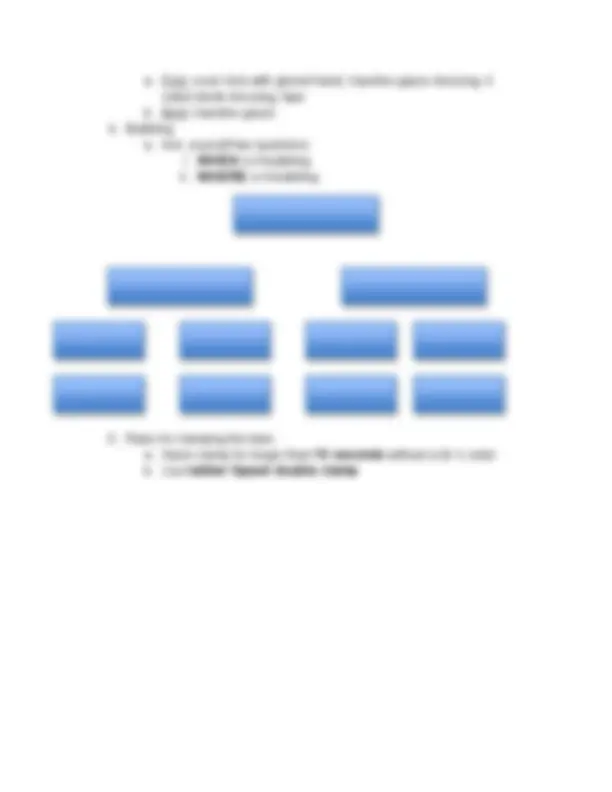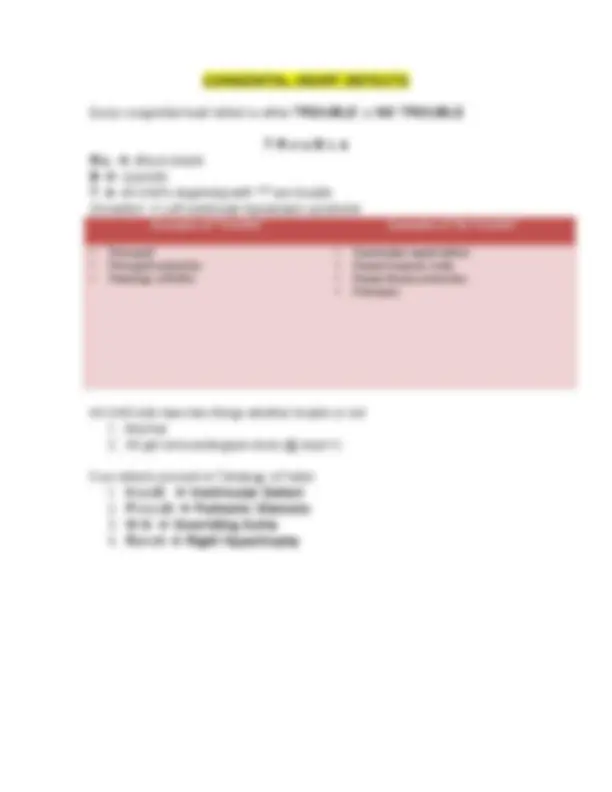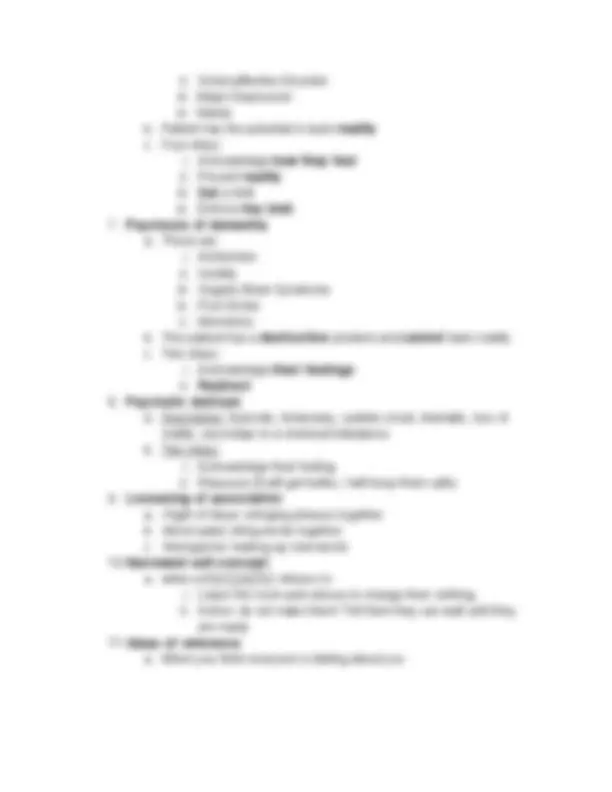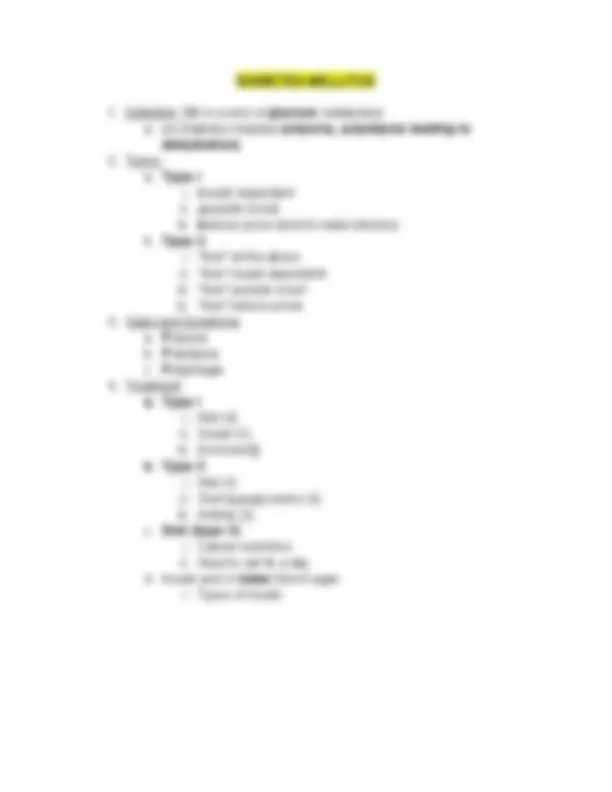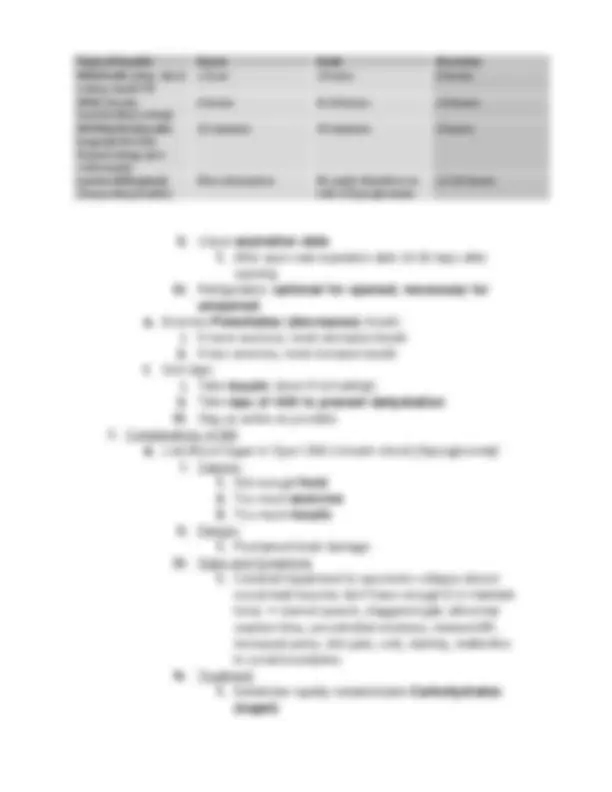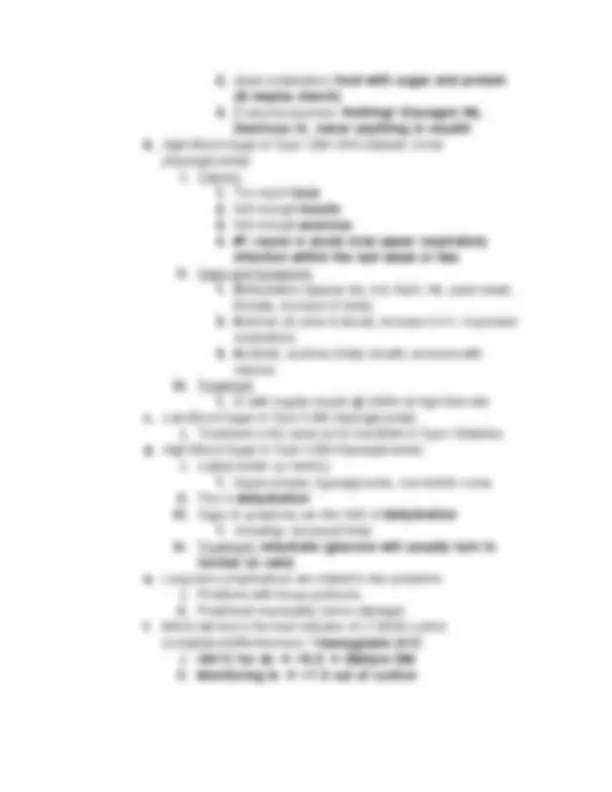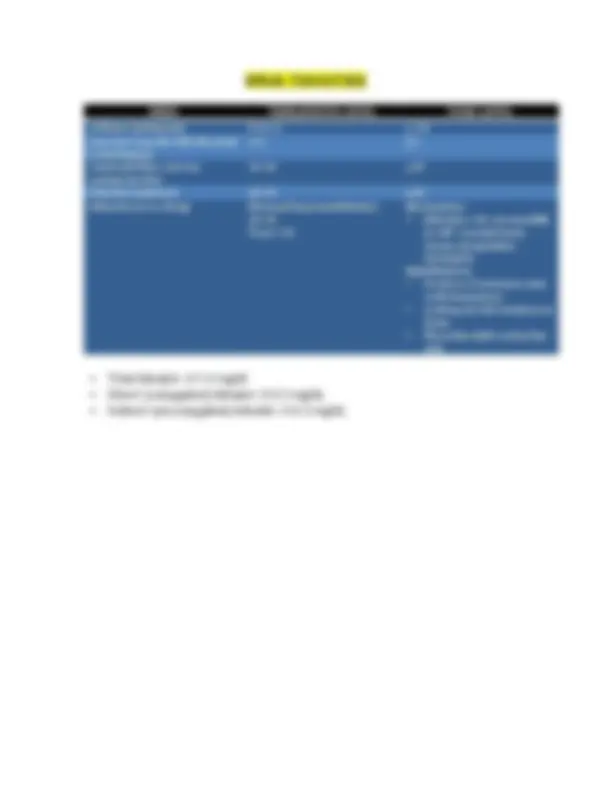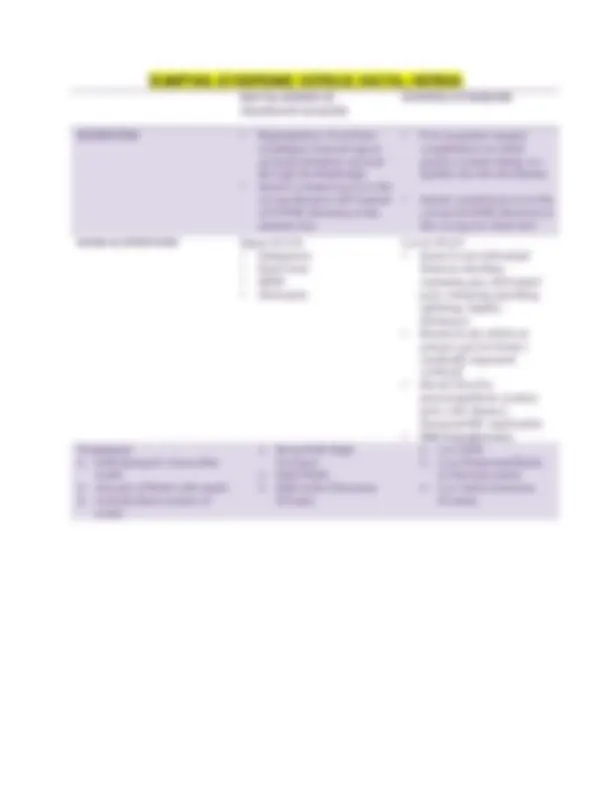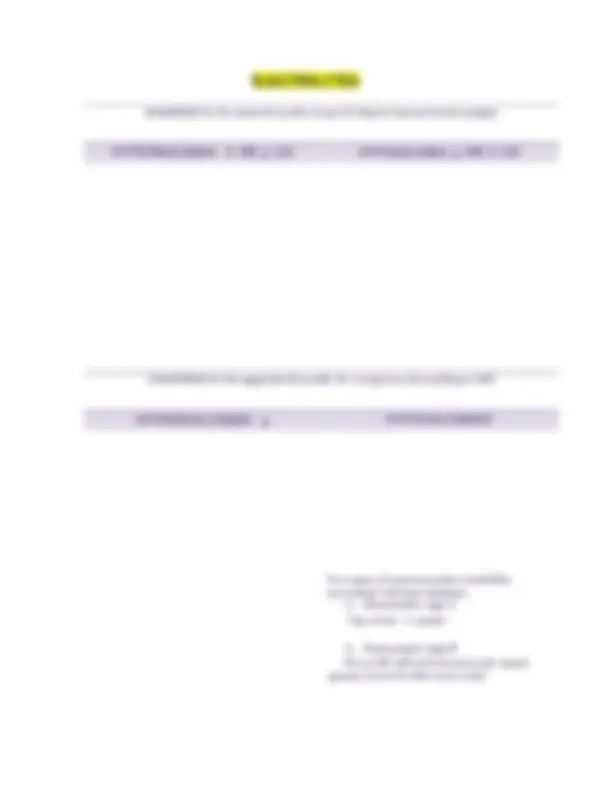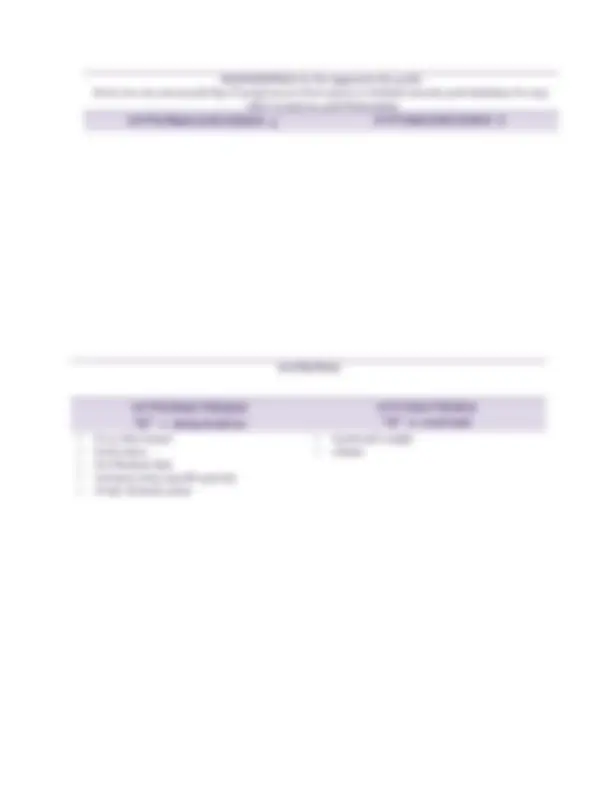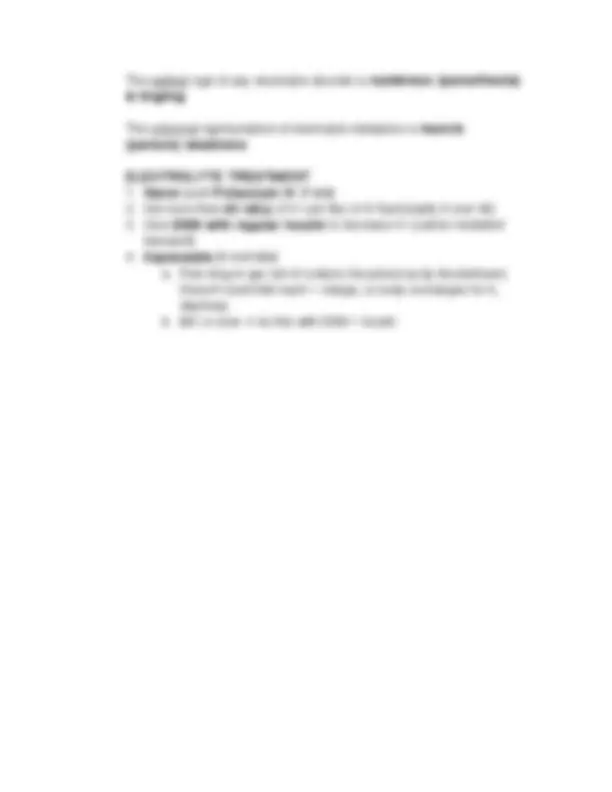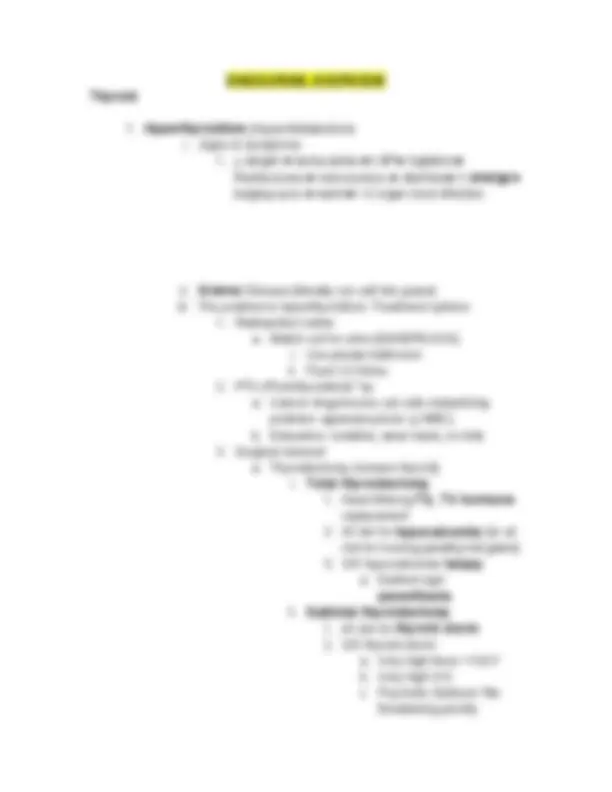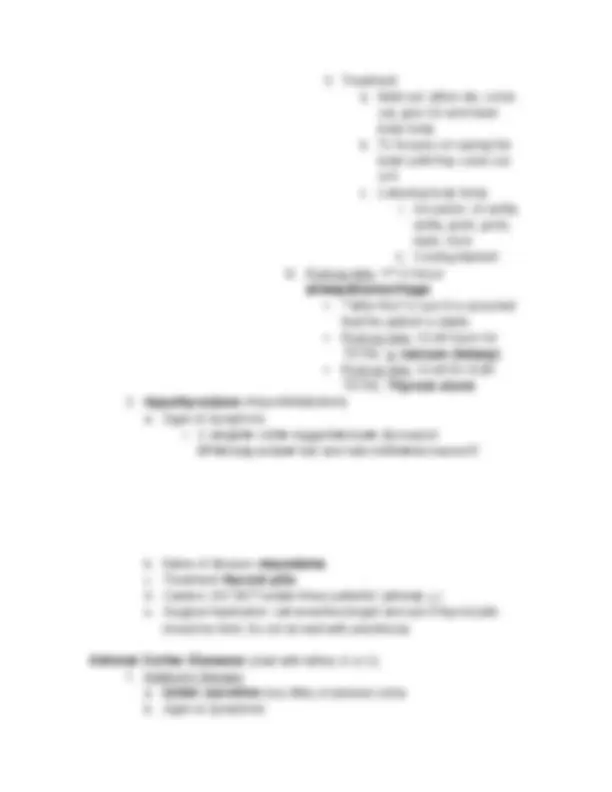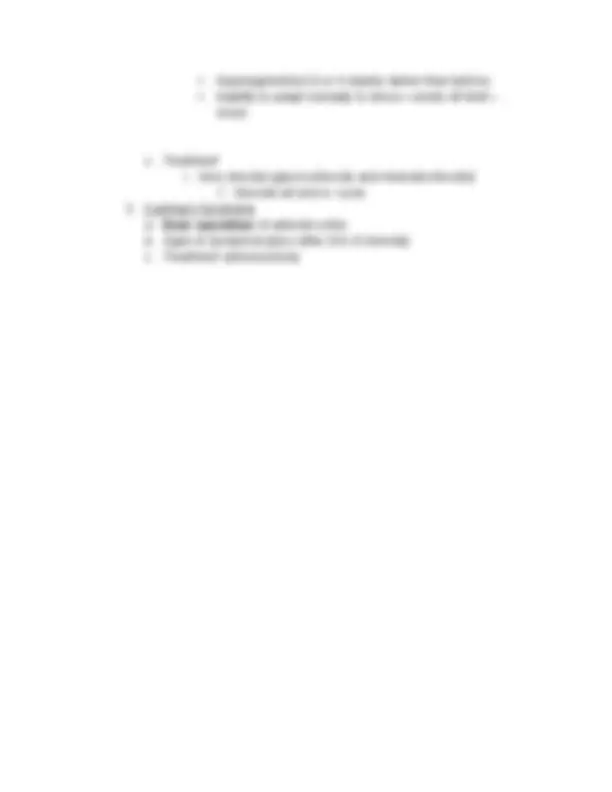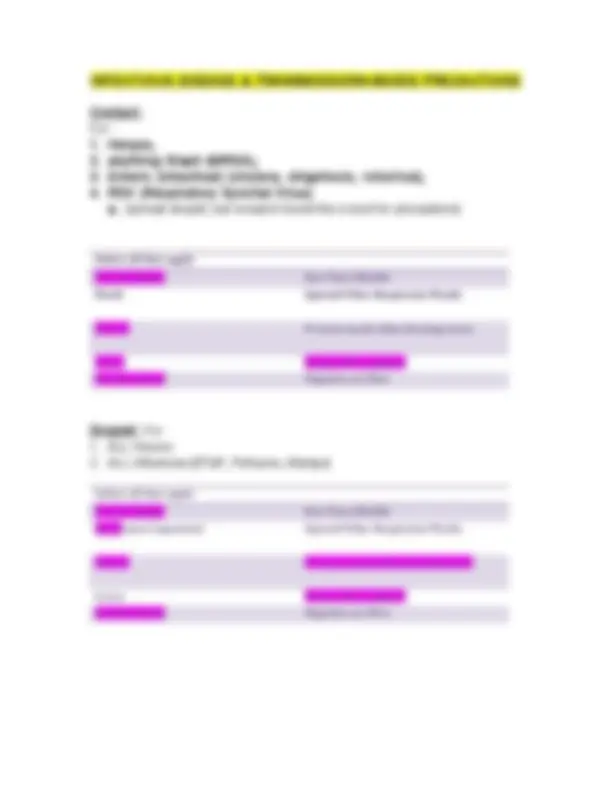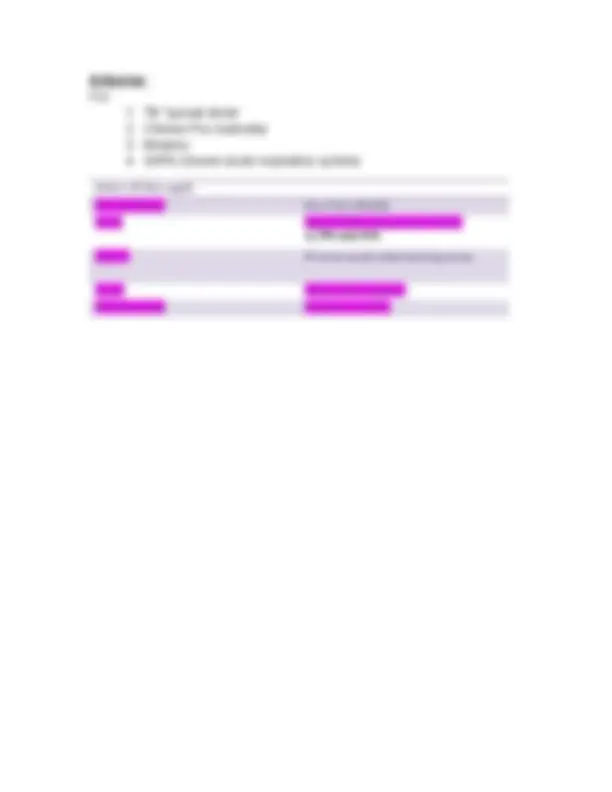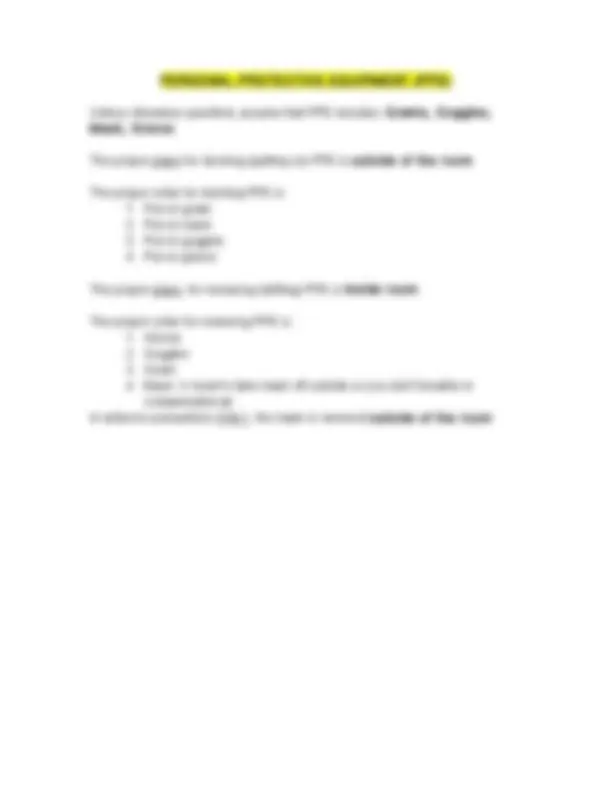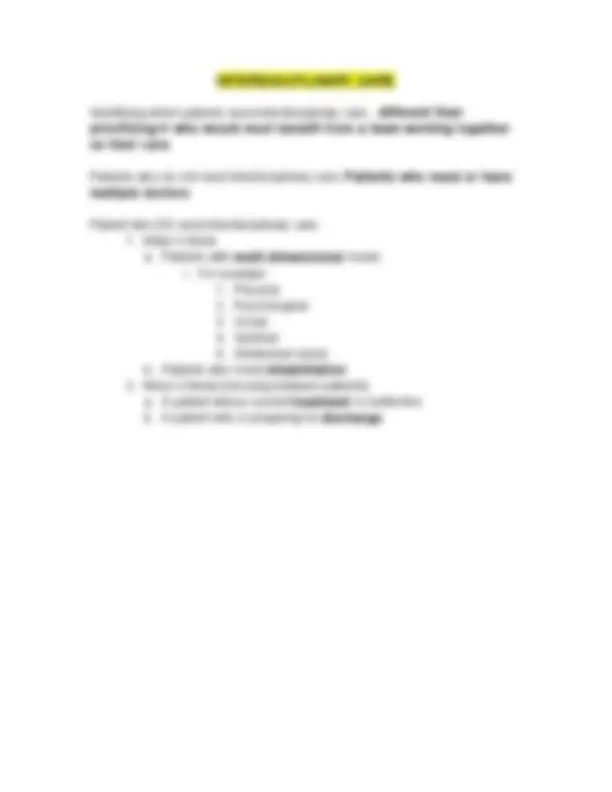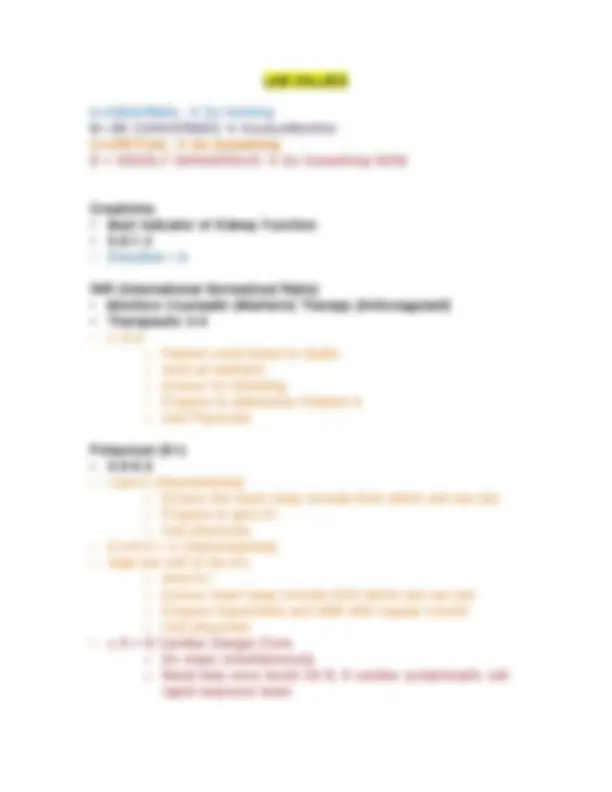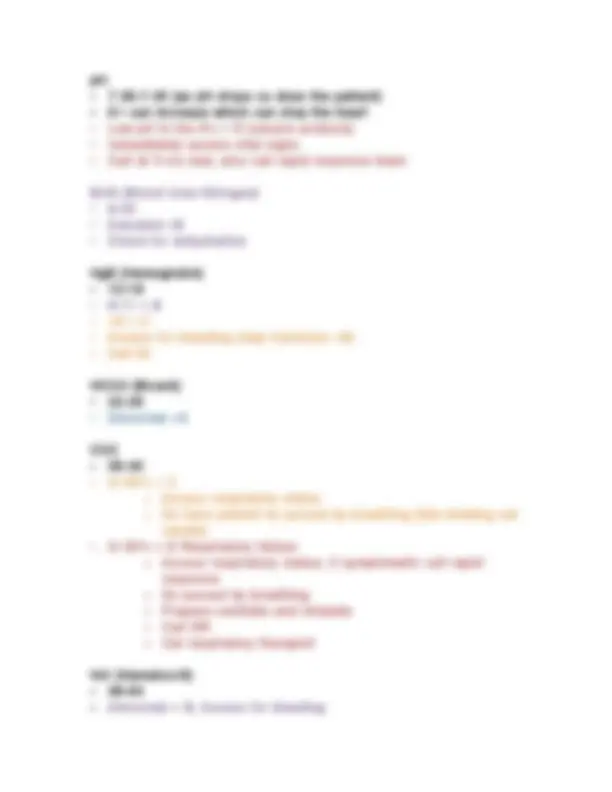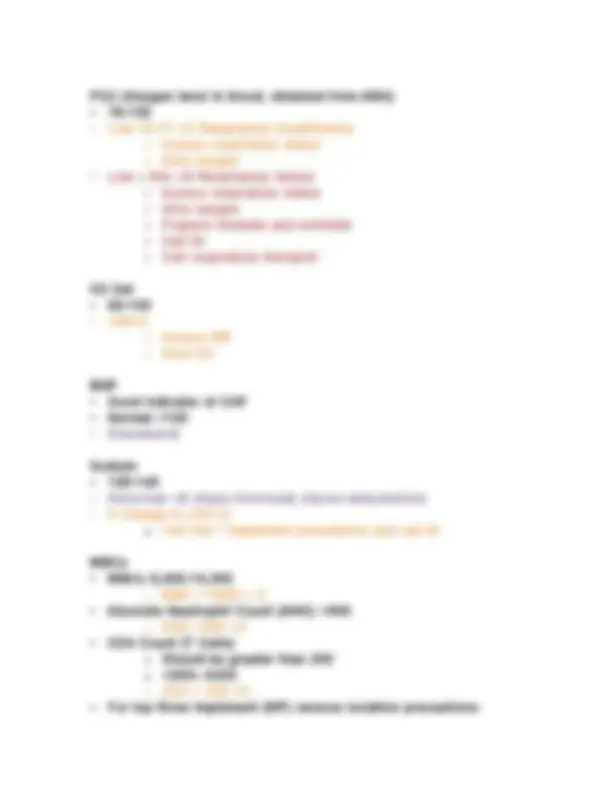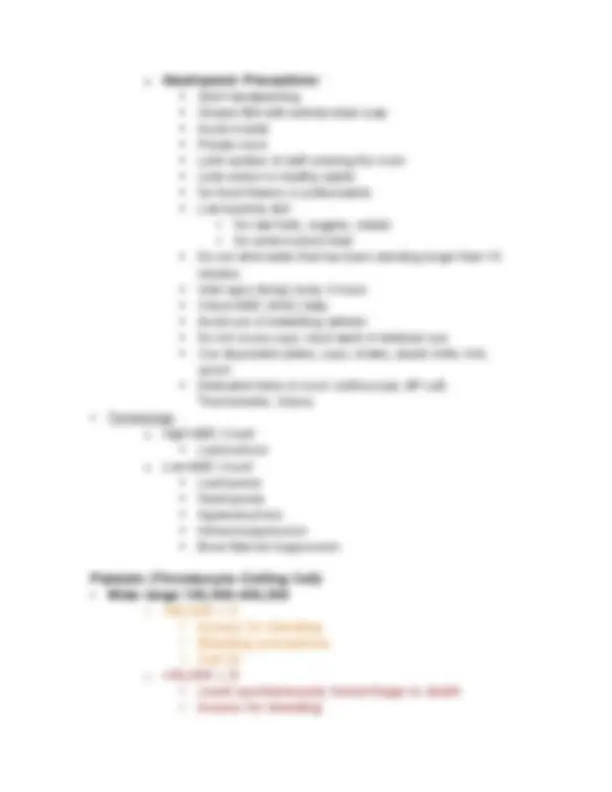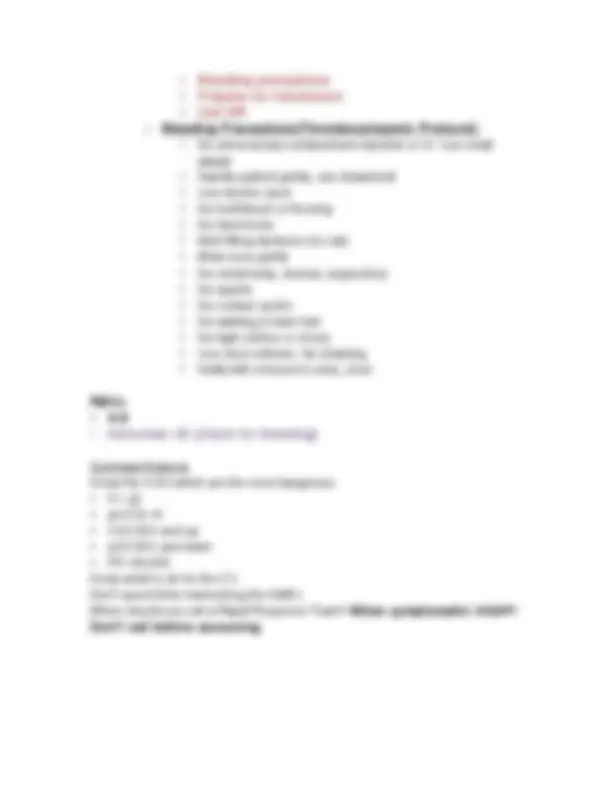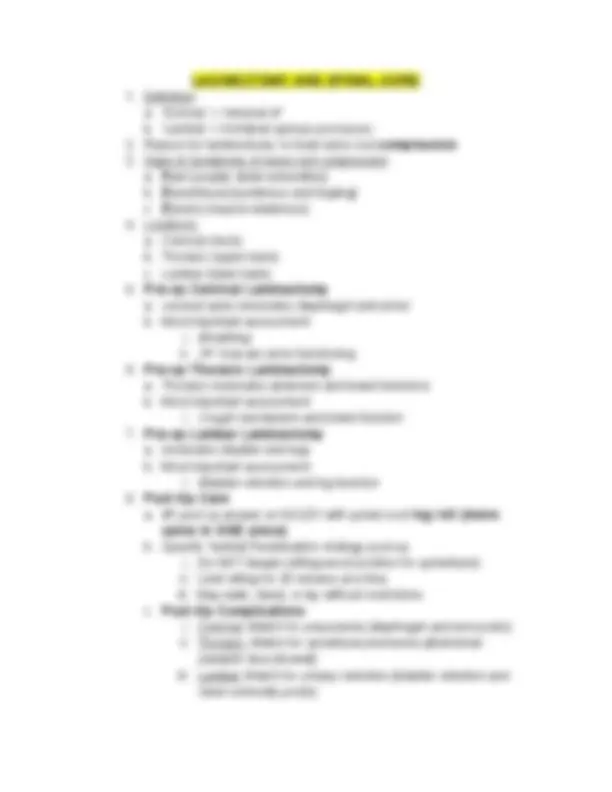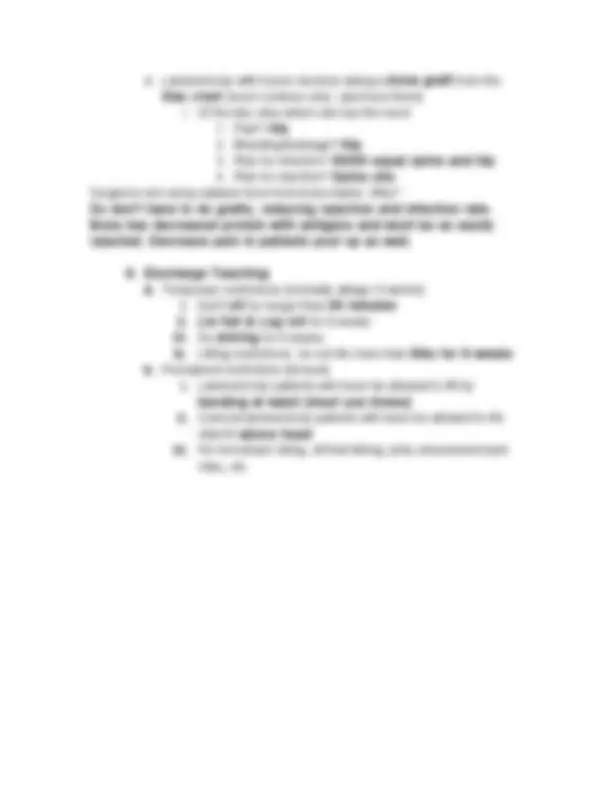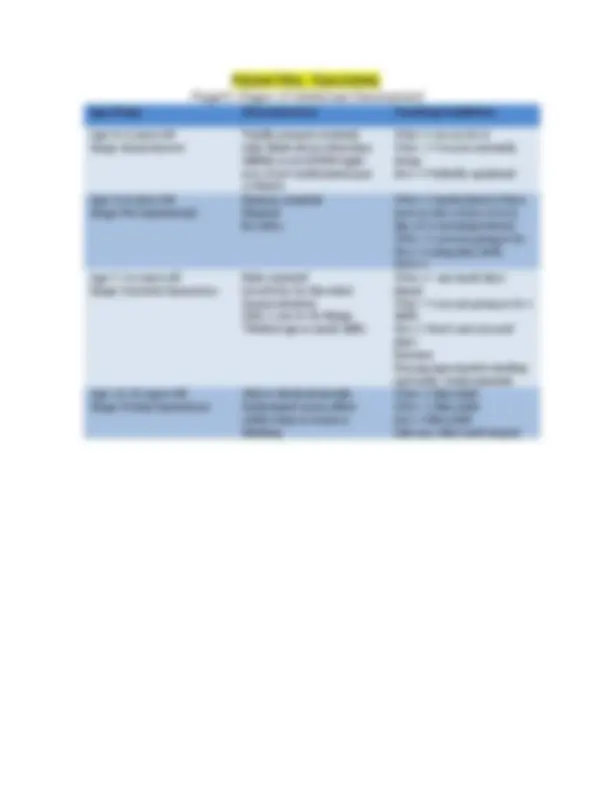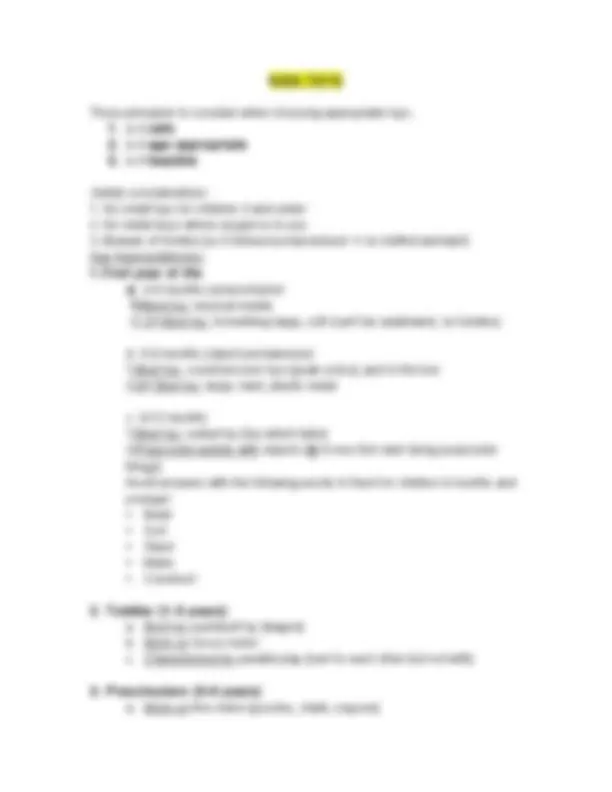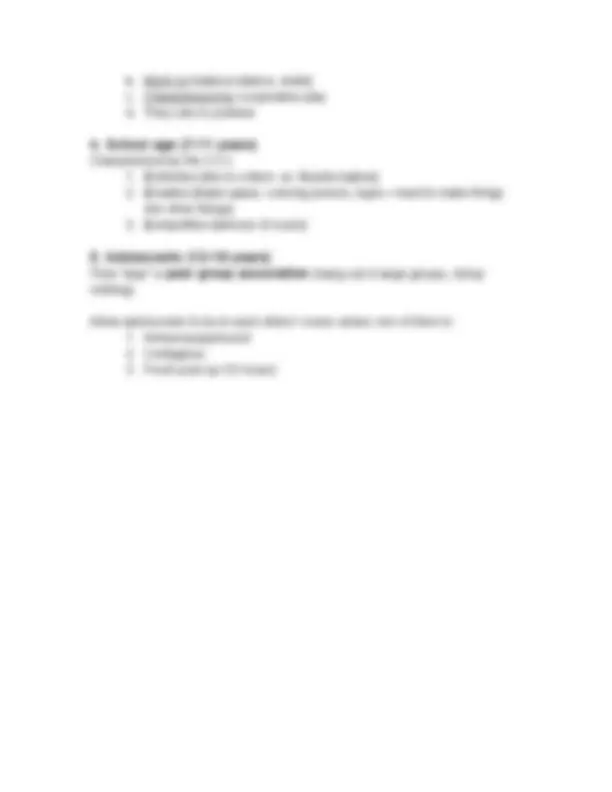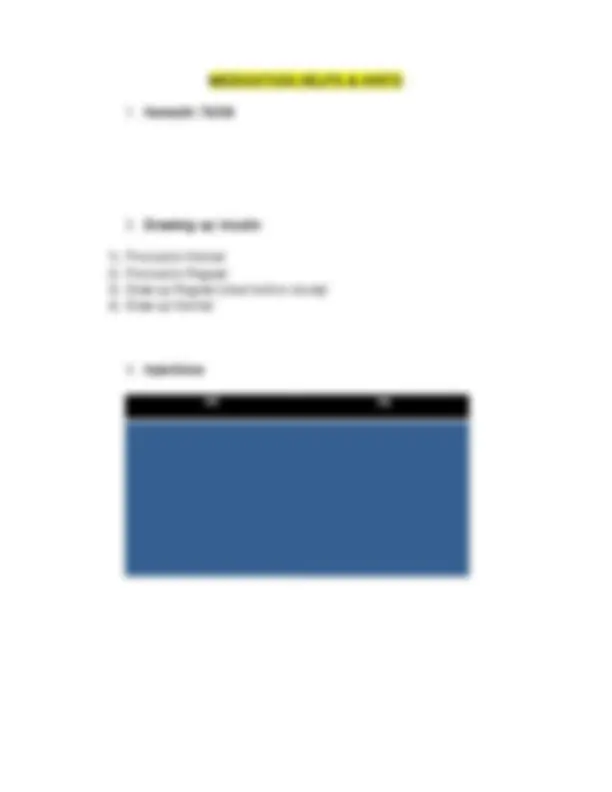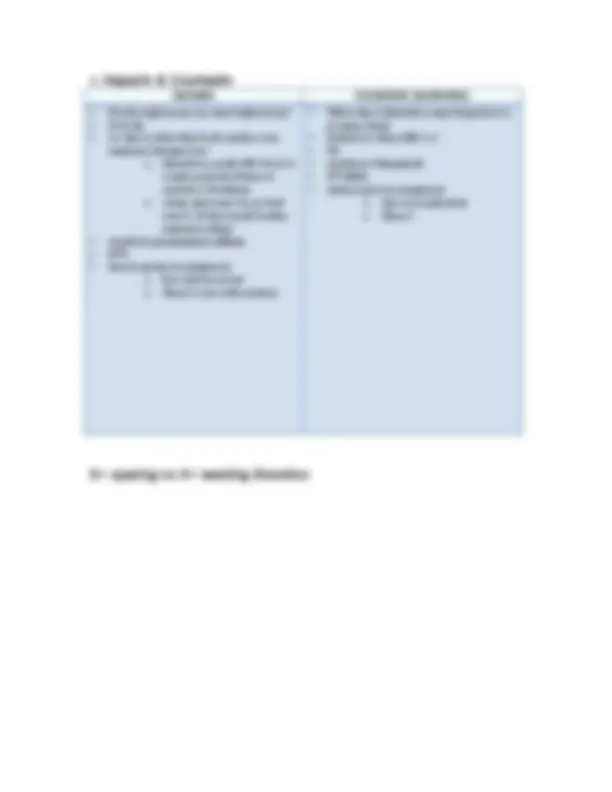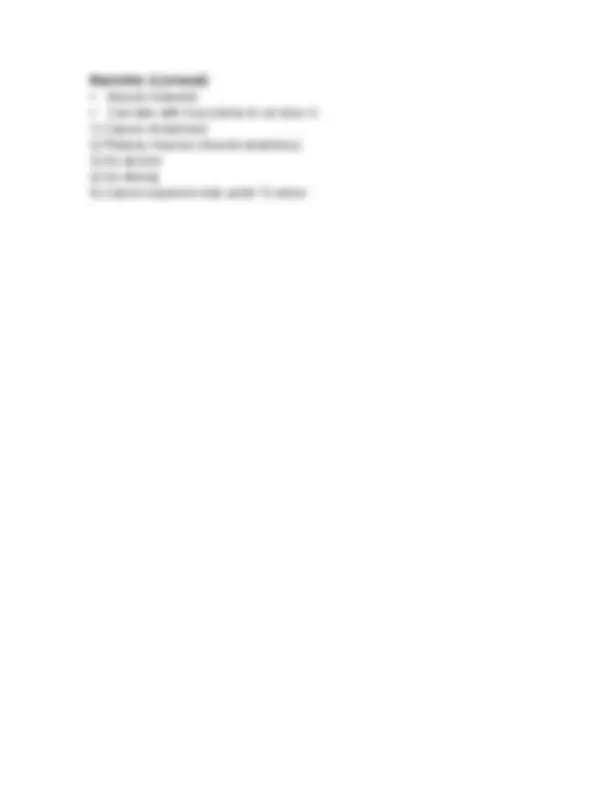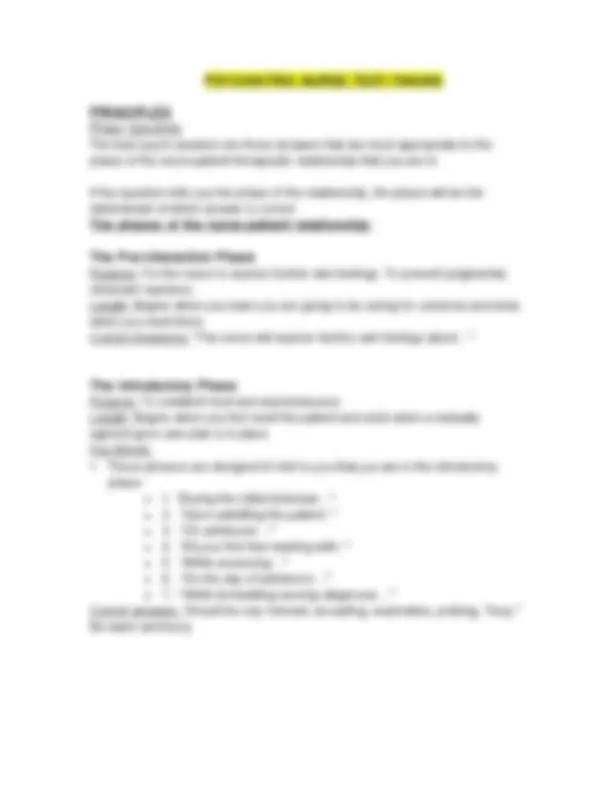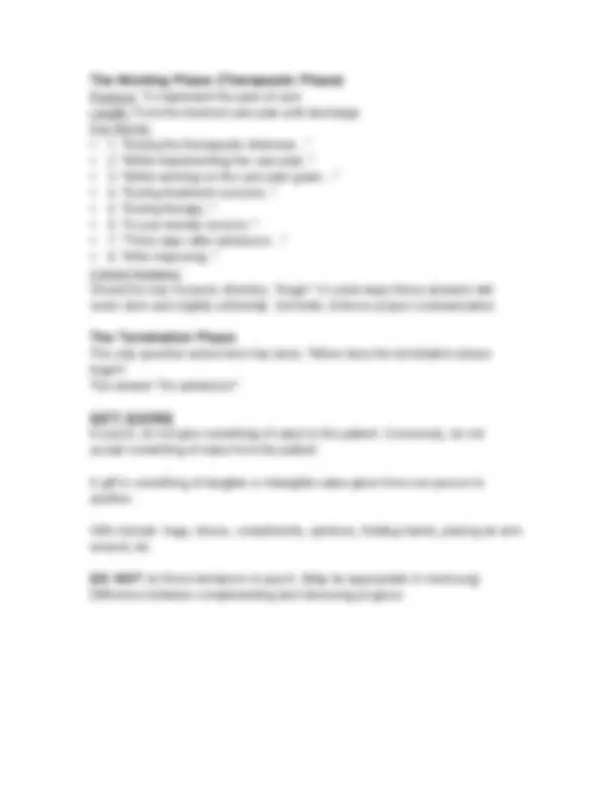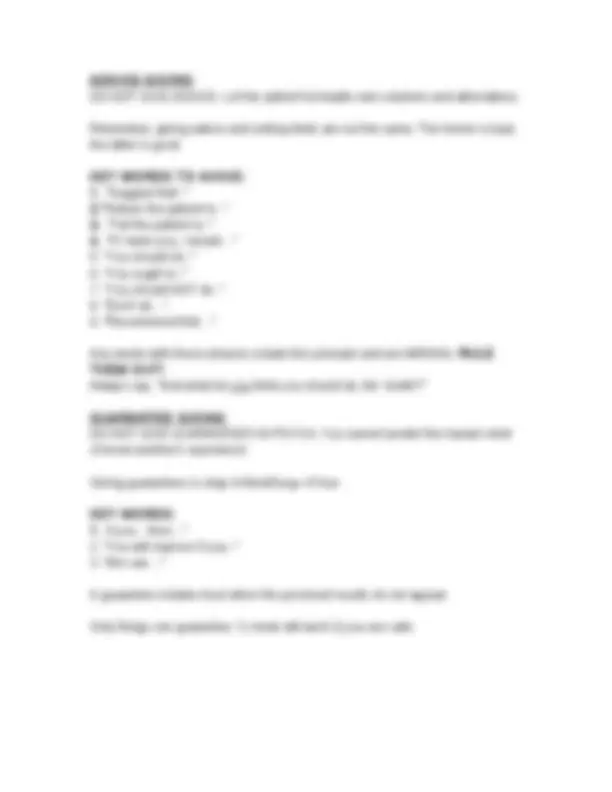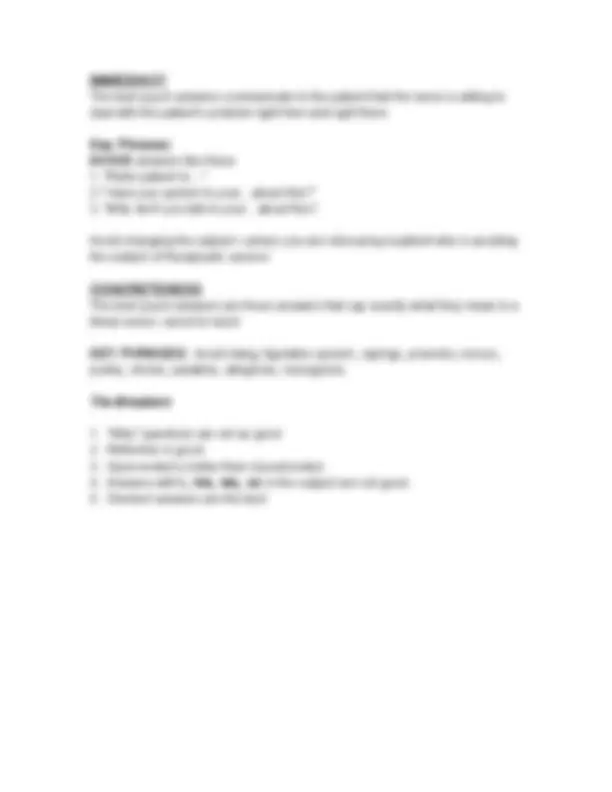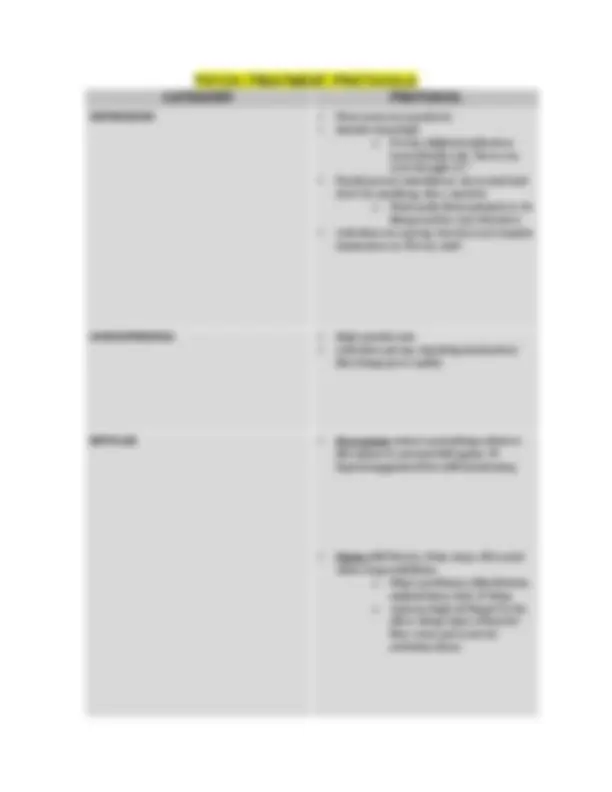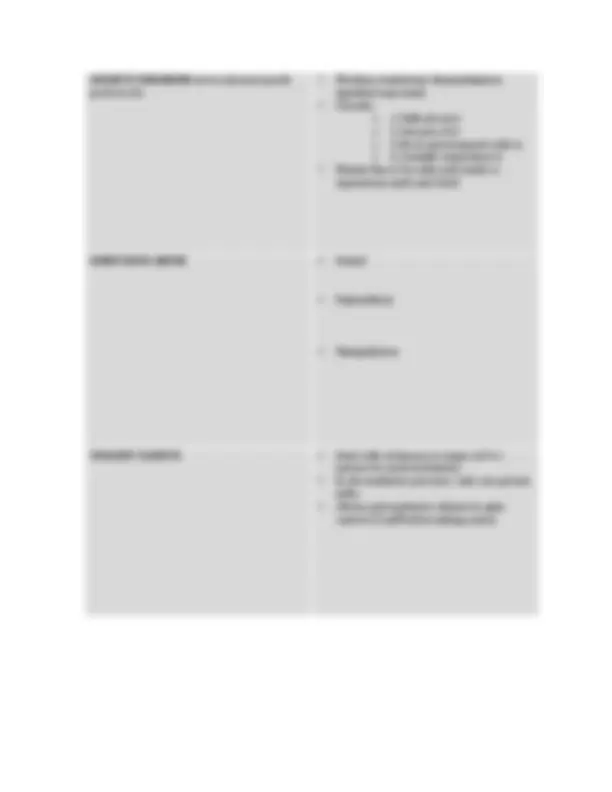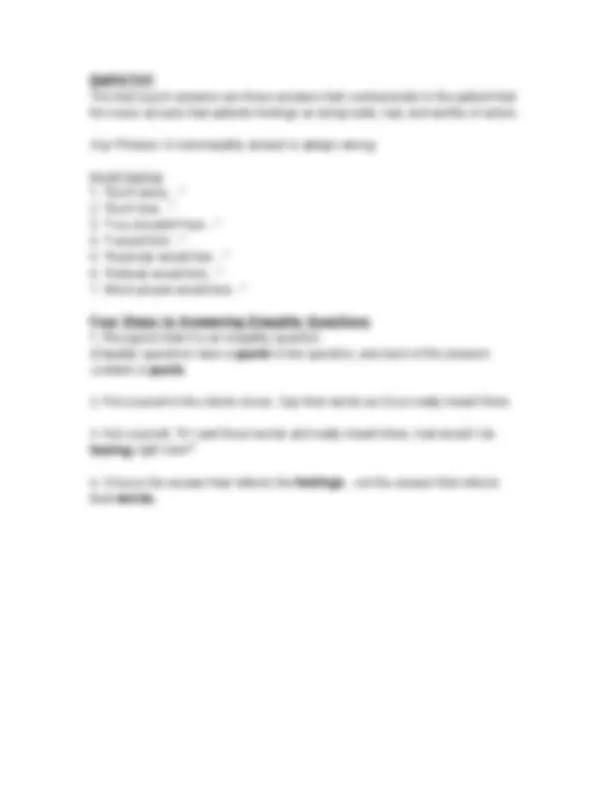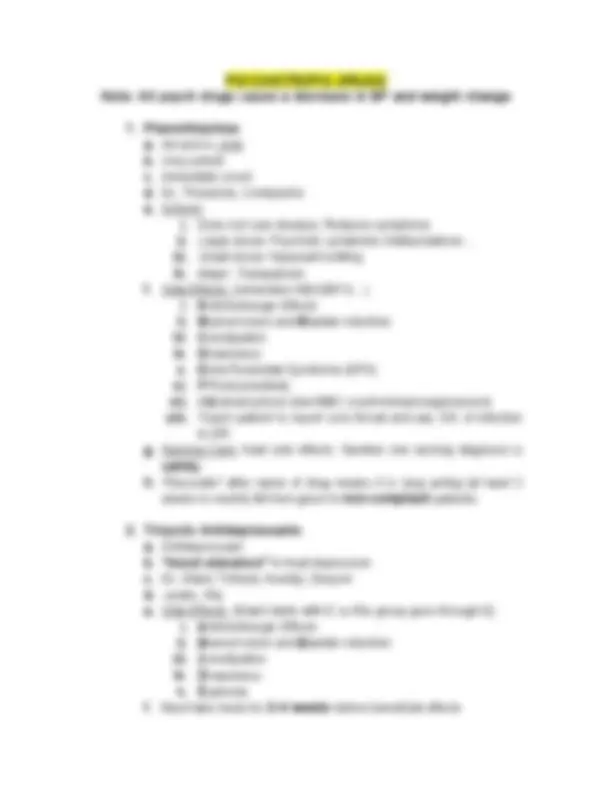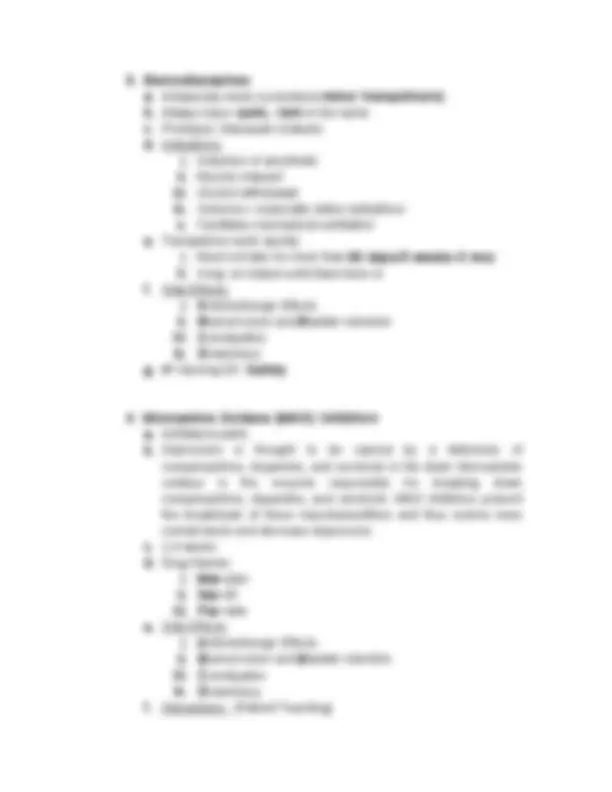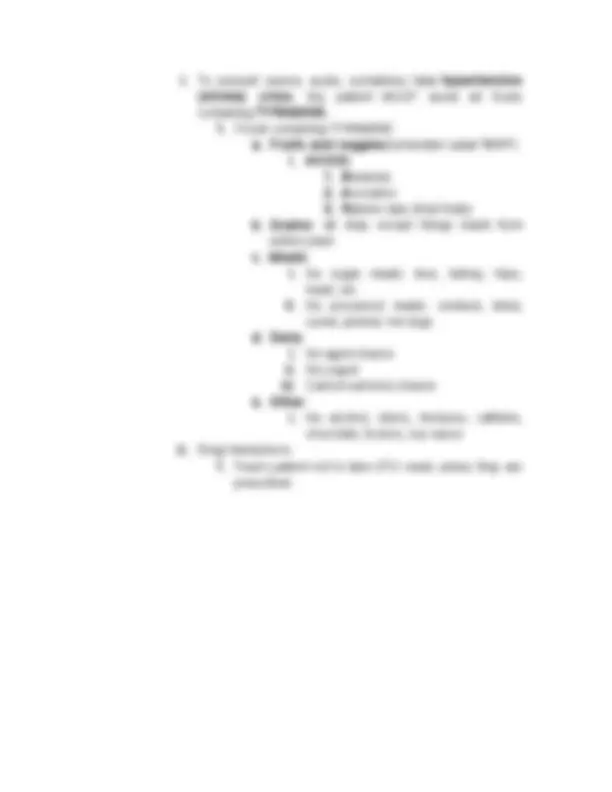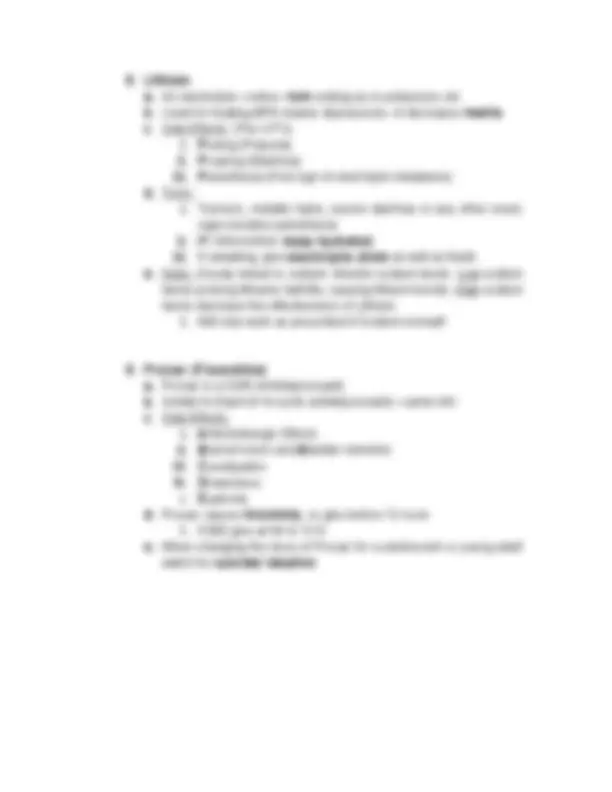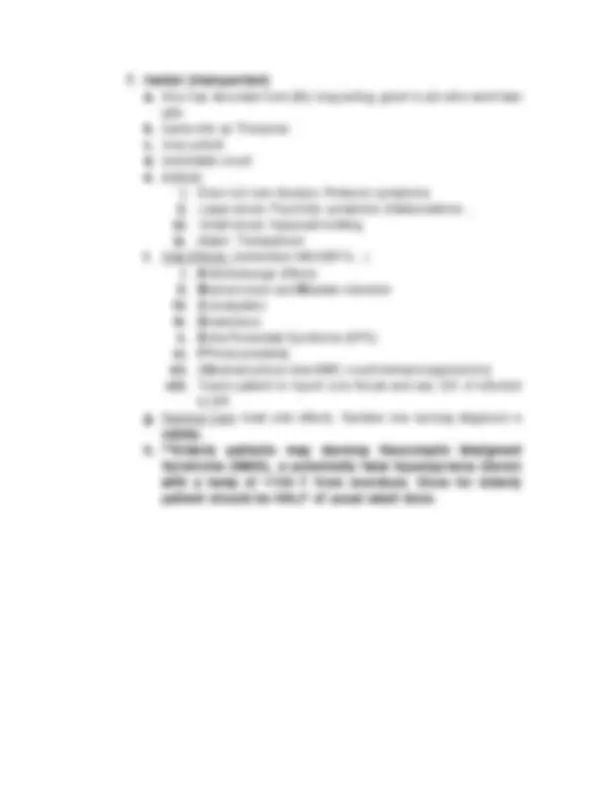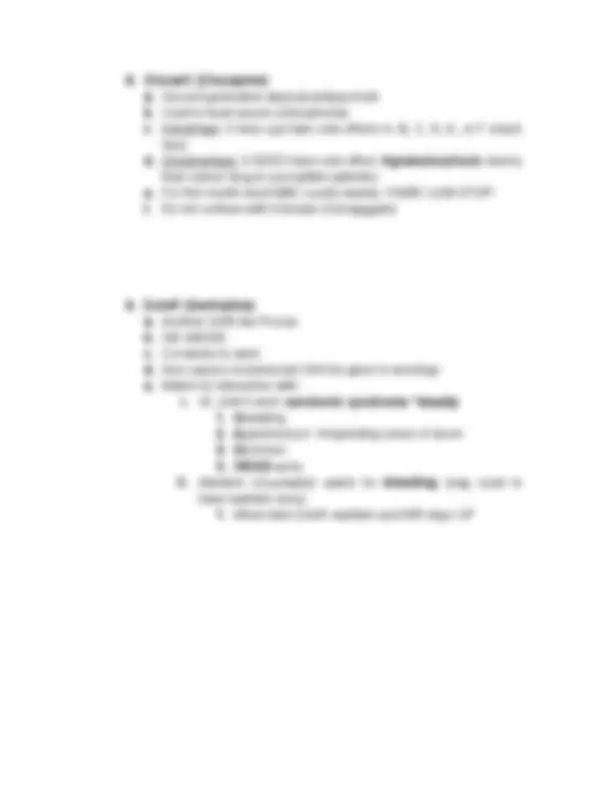Download Essential HESI/NCLEX/ATI notes and more Study notes Nursing in PDF only on Docsity!
Mz.ANTICHOLINERGIC vs. CHOLINERGIC EFFECTS
ANTICHOLINERGIC CHOLINERGIC
- ↓ Mucus
- Bronchodilation
- Dry mouth
- Dry eyes
- Urinary retention
- Dry skin
- Constipation
- Shut down GI
- Prevents V when trying to intubate
- Bronchorrhea (large amounts of mucus in airway)
- Bronchoconstriction
- Salivation
- Lacrimating
- Urination
- Diaphoresis/Diarrhea
- GI Upset
- Emesis
ACID BASE GASES
A. ABG Interpretation a. Rule of the B’s i. If the pH and the BICARB (HCO3) ii. Are BOTH in the same direction, iii. Then it is METABOLIC b. ↓ pH = acidosis c. ↑ pH= alkaline B. Values a. Normal pH = 7.35 – 7. b. Normal Bicarb= 22- 26 c. PaO2= 80-100 mmHg d. PaCO2= 35-45 mmHg e. SaO2= 95-100% C. Signs & Symptoms of Acid-Base Imbalance a. As the pH goes, so goes the patient except for Potassium (bc it will try to compensate) pH UP ↑ K↓ [ALKALOSIS] pH DOW N ↓ K↑ [ACIDOSIS]
- Tachycardia
- Tachypnea
- Diarrhea
- Tremors
- Seizure
- Hyperreflexia
- Agitated
- Bradycardia
- Bradypnea
- Hypotension
- ↓ lucidity
- anorexia
- coma
- lethargy
- Borborygmi (↑ bowel sounds)
- Hypertension
- Palpitations
- Tetany
- Anxiety/Panic
- Poly
- cardia arrest
- suppressed, decreased, falling
D. Causes of Acid-Base Imbalance a. First ask, “Is it Lung?” i. If YES-! then it is Respiratory b. Then ask yourself: i. Are they Overventilating or Underventilating?
- If Overventilating! pick Alkalosis
- If Underventilating! pick Acidosis c. If not lung, then it’s Metabolic i. If the patient has prolonged gastric vomiting or suction, pick Metabolic Alkalosis ii. For everything else that isn’t lung, pick Metabolic Acidosis
- Also, if you don’t know what to pick choose Metabolic Acidosis
VENTILATOR ALARMS
- High Pressure Alarms are triggered by ↑ resistance to air flow and can be caused by obstructions of three types: a. Kinked Tube i. NRS ACTION: Unkink it b. Water in tubing (caused by condensation) i. NRS ACTION: Empty it/Remove H2O c. Mucus in airway i. NRS ACTION: Turn, C&DB; only use suction if C&DB fails, as a last resort 2. Low Pressure Alarms are triggered by ↓ resistance to air flow and can be caused by disconnections of the: a. Tubing i. NRS ACTION: Pay attention to where tubing
do things for them or make decisions for them. ii. Codependency: When the significant other derives positive self-esteem from doing other things for or making decisions for the abuser. iii. Treatment:
- Set boundary (limits) and enforce them. Agree in advance on what requests are allowed then enforce the agreement
- Work on the self-esteem of the codependent person. c. MANIPULATION i. Definition: When the abuser gets the significant other to do things for him/her that are not in the best interest of the Significant Other. The nature of the act is dangerous or harmful to the significant other ii. Treatment:
- Set limits and enforce
- Its easier to treat than dependency/codependency because nobody likes to be manipulated
- Wernicke’s (Korsakoff’s) Syndrome a. Psychosis induced by Vitamin B1 (Thiamine) deficiency. b. Primary symptom: amnesia with confabulation (making up stories to fill in memory loss—believe as true) c. Characteristics: i. Preventable
- By giving B1 vitamins ii. Arrestable
- Can stop from getting worse- not imply better iii. Irreversible
- Dementia symptoms don’t get better—only worse
- Antabuse/Revia a. Disulfiram (drugs used for alcoholism b. Aversion Therapy c. Onset and duration of effectiveness: 2 weeks i. Take drugs 2 weeks and builds up in blood to a level that when drinking alch will become horribly sick; if off for two weeks, will be able to drink without sickness again d. Patient teaching: Avoid ALL forms of alcohol to avoid nausea, vomiting, and possibly death, including: i. Mouthwash, aftershave, perfumes/cologne, insect repellant,
vinigarettes (salad dressings), vanilla extract, elixirs (contains alch-OTC med), alcohol prep pad, alch sanitizers
OVERDOSE VS. WITHDRAWAL
First ask yourself, is the drug an upper or a downer?
UPPERS ↓ DOWNERS ↓ Names:
- Caffeine
- Cocaine
- PCP/LSD (Psychedelic hallucinogens)
- Methamphetamines-speed
- ADHD- adderrall/Ritalin
- Bath Salts (Cath-Kath)
Names :
Signs/Symptoms:
- Tachycardia
- Hypertension
- Diarrhea
- Agitation
- Tremors
- Clonus
- Belligerence
- Seizures
- Exaggerated, shrill, high pitched cry
- Difficult to console
Signs/Symptoms:
- Bradycardia
- Hypotension
- Constipation
- Constricted pupils
- Flaccidity
- Respiratory arrest
- Decreased core body temp
AMINOGLYCOSIDES
- Think “A mean old mycin”
- Powerful antibiotics—to treat severe, life-threatening, resistant infections
- All aminoglycosides end in ‘mycin’, but not all drugs that end in mycin are aminoglycosides. For example.. a. Azithromycin, clarithromycin, erythromycin thromycin! NOT
- Examples of aminoglycosides: Streptomycin, Cleomycin, Tobramycin, Gentamicin, Vancomycin, Clindamycin
- Toxic Effects: a. The most famous feature of the worlds most famous mouse (ears) i. Toxic effect: ototoxicity ii. Must monitor hearing, balance, tinnitus b. The human ear is shaped like a kidney i. Toxic effect: nephrotoxicity ii. Monitor: creatinine
- Best indicator of kidney function
- 0.6- 1 .2 mg/dL c. The number 8 drawn inside the ear reminds you of: i. Cranial nerve 8 (Drug toxic to) ii. Frequency of administration: Every 8 hours
- Route of Administration a. Give IM or IV b. Do not give PO (not absorbed) except in these two cases: i. Hepatic encephalopathy 1. Also called Liver Coma, Ammonia-Induced Encephalopathy 2. When want a sterile bowel 3. Due to a high ammonia level ii. Pre-op Bowel surgery
- REMEMBER this military sound off: a. NEOmycin b. KANmycin c. WHO CAN STERILIZE MY BOWEL? NEO KAN d. ^ PO, 2 bowel sterilizers
- Trough and Peak Levels a. Reason for drawing TAP levels: narrow therapeutic range
b. Time table: ROUTE TROUGH (lowest) PEAK (highest) Sublingual 30 min before next dose 5 - 10 mins after drug dissolve
IV 30 min before next dose 15 - 30 min after drug finished
IM 30 min before next dose 30 - 60 min after drug given
SQ 30 min before next dose See diabetes lecture
PO 30 min before next dose Forget about it.
BIOTERRORISM
- Categories of Biological Agents a. Category A (Most serious) i. Small pox ii. Tularemia iii. Anthrax iv. Plague v. Hemorrhagic fever [Ebola] vi. Botolism b. Category B i. All others. A long list. c. Category C i. Hanta virus ii. Nipeh virus
- Category A Biological Agents a. Smallpox i. Inhaled transmission/on Airborne Precautions ii. Dies from septicemia. Blood infection. *only class A that dies from this. iii. Rash starts around mouth first (early ID & isolation is crucial to contain) b. Tularemia i. Inhaled
- Urination
- Diaphoresis/diarrhea
- GI upset
- Emesis
- All chemical agents require only soap and water cleansing except for Sarin, which requires a bleach a. Nursing Actions: Bioterrorism- Isolation, Antibiotics b. Chemical: Decontamination i. Send all suspected cases to decontamination center ii. Remove all clothing iii. Chemical hazard double bag iv. Incinerated v. Shower in soap and water (bleach- sarin) vi. Discharged in government clothes
CALCIUM CHANNEL BLOCKERS
Note: They are like Valium for your heart
- Calcium Channel Blockers: Negative [ ino, chrono, dromo ] Dig is only drug that mixes + & - effects; other 99% either have + or - ACTION DEFINITION POSITIVE↑ NEGATIVE↓ Inotropic Strength of heartbeat
Strong Weak
Chronotropic Rate of heartbeat Fast Slow Dromotropic Conductivity Excitable Blocks/Slows conduction
- What do Calcium Channel Blockers treat? (Indications) a. Antihypertensives (BP way UP-relaxes blood vessels) b. Antianginal (relaxes- reduces O2 demand) c. Anti Atrial Arrthymia (does not tx ventricular arrthymias)
- Side Effects(↑): a. Headache b. Hypotension c. Bradycardia
- Names of Calcium Channel Blockers a. – soptin (Verapeunil) b. – zem c. – dipine
- Nursing Actions: before administrating – BP systolic lower than 100..if < 100 hold and call Dr
CARDIAC ARRYTHMIAS
- Terminology a. “QRS depolarization” always refer to ventricular (not atrial, junctional, or nodal) b. “P wave” refers to atrial
- Six rhythms tested on NCLEX a. Asystole i. A lack of QRS depolarization’s (a straight line) b. Atrial flutter i. Rapid P-wave depolarization’s in a saw-tooth (flutter) c. Atrial fibrillation i. Chaotic P-wave depolarization’s (lacks any discernable pattern) d. Ventricular fibrillation i. Chaotic QRS depolarization’s e. Ventricular tachycardia i. Wide, bizarre QRS’s ii. Tachy is always discernable repeating pattern f. Premature ventricular contractions (PVC) i. Periodic wide, bizarre QRS’s ii. Generally low to moderate priority. unless everyone else has a normal rhythm iii. Be concerned, if:
- More than 6 per minute
- 6 in a row
- PVC falls of T-wave of previous beat
- Lethal arrhythmias a. Asystole b. V-fib
- Potentially life threatening arrhythmia: V-tach a. Pulseless v-tach; same as asystole and v. fib and would depend on how long down b. After 8 mins consider dead
- Treatment a. PVC’s i. Lidocaine (Ventricular, lasts longer) , Amiodorone b. V Tach
CHEST TUBES
The purpose for chest tubes is to re-establish negative pressure in the pleural space
- In a pneumothorax, the best tube removes air
- In a hemothorax, the chest tube removes blood
- In a pnemohemothorax, the chest tube removes air and blood
Location of chest tubes:
- Apicals (HIGH) for Air a. Label “A”- up high
- Basilar (LOW) for Blood a. Label “B”- placed at base; bottom of lung
Examples
- How many chest tubes (and where) for unilateral pneumohemothorax? a. 2; apical and basilar all on same side
- How many chest tubes (and where) for bilateral pneumothorax? a. 2; apical right and left
- How many chest tubes (and where) for post-op chest surgery? a. 2; apical and basilar unilateral b. Exception: If surgery total pneymonectomy then! no chest tube bc no pleural space c. Always assume chest trauma and surgery is unilateral
Problem Solving
- What do you do if you kick over the collection bottle? a. Not a big deal; can just sit it right back up; have take a couple deep breaths
- What do you do if the water seal breaks? a. This is more serious, because it is allowing air in creating a 2 way b. First: Clamp chest tube (Better no way than 2 way for brief period of time) **in routine care never clamp chest tube!! c. Best: Submerge i. Cut tube away (down) by device; submerge under water preferably sterile-then unclamp
- What do you do if the chest tube comes out?
a. First: cover hole with gloved hand; Vaseline gauze dressing; 4 sided sterile dressing; tape b. Best: Vaseline gauze
- Bubbling a. Ask yourself two questions: i. WHEN is it bubbling ii. WHERE is it bubbling
- Rules for clamping the tube: a. Never clamp for longer than 15 seconds without a Dr.’s order b. Use rubber tipped double clamp
CRUTCHES, CANES, & WALKERS
- How to measure: 2 - 3 finger widths below anterior anxillary fold to a point lateral to and slightly in front of foot
- When the handgrip is properly placed, the angle of elbow flexion will be 30 degrees
- Types of gaits: a. 2 - Point Gait i. Step One: Move one crutch and opposite foot together ii. Step Two: Move other crutch and other foot together iii. Remember: 2 points together for a 2 point gait iv. Examples: one knee replacement b. 3 - Point Gait i. Step One: Move two crutches and bad leg together ii. Step Two: move good foot by self iii. Remember: 3 point is called 3 point because three points touch down at once iv. Examples: Stairs c. 4 - Point Gait i. Step One: One crutch ii. Step Two: Opposite foot iii. Step Three: Other Crutch iv. Step Four: Other food v. Examples: total both knee right after surgery d. Swing-through: for two braced extremities i. Examples: arthritis braced legs
- When to use each gait a. Use the even numbered gaits (2&4 point) when weakness is evenly distributed (bilateral). Two point for mild problem; four-point for severe problem b. Use the odd numbered gait (3 point) when one leg is odd (unilateral problem)
- Stairs: which foot leads when going up and down stairs on crutches? a. Remember: UP with the good; DOWN with the bad b. The crutches always move with the bad leg
- Cane a. Hold can on the strong (unaffected) side b. Advance cane with the weak side for a wide base of support
- Walkers
a. Pick it up, set it down, walk to it b. Tie belongings to side of walker, not front c. Getting out of chair to walker- always push, never pull (same for cane, crutches)
DELUSIONS, HALLUCINATIONS, & ILLUSIONS
- Psychotic vs Non-Psychotic a. A non-psychotic person has insight & is reality based b. A psychotic person has NO insight and is NOT reality based
- Delusions a. Definition: a delusion is a false, fixed belief or idea or thought. There is no sensory component. b. Three types of delusions: i. Paranoid or Persecutory: false, fixed belief that people are out to harm you. ii. Grandiose: False, fixed belief that you are superior iii. Somatic: False, fixed belief about parts of your body
- Hallucinations a. Definition: a hallucination is a false, fixed sensory experience b. Five types of hallucinations: i. Auditory (most common* hearing) ii. Visual iii. Tactile iv. Olfactory v. Gustatory
- Illusions a. Definition: An illusion is a misinterpretation of reality. It is a sensory experience. b. Differentiation between illusions & hallucinations: with illusions there is a referent in reality
- When dealing with a patient experiencing delusions, hallucinations or illusions, first ask yourself, “What is their problem?” a. Functional Psychosis b. Psychosis of Dementia c. Psychotic Delirium
- Functional Psychosis a. These are: i. Schizophrenia
DIABETES MELLITUS
- Definition: DM is a error of glucose metabolism a. (vs Diabetes Insipidus polyuria, polydipsia leading to dehydration)
- Types: a. Type I i. Insulin dependent ii. Juvenile Onset iii. Ketosis prone (tend to make ketones) b. Type II i. “Non” all the above ii. “Non” insulin dependent iii. “Non” juvenile onset iv. “Non” ketosis prone
- Signs and Symptoms a. Polyuria b. Polydipsia c. Polyphagia
- Treatment a. Type I i. Diet (3) ii. Insulin (1) iii. Exercise(2) b. Type II i. Diet (1) ii. Oral hypoglycemics (3) iii. Activity (2) c. Diet (type II) i. Calorie restriction ii. Need to eat 6x a day d. Insulin acts to lower blood sugar i. Types of insulin
ii. Check expiration date
- After open new expiration date 20-30 days after opening iii. Refrigeration: optional for opened; necessary for unopened e. Exercise Potentiates (decreases) insulin: i. If more exercise, need decrease insulin ii. If less exercise, need increase insulin f. Sick days i. Take insulin (even if not eating!) ii. Take sips of H20 to prevent dehydration iii. Stay as active as possible
- Complications of DM a. Low Blood Sugar in Type I DM (=insulin shock) [Hypoglycemia] i. Causes:
- Not enough food
- Too much exercise
- Too much insulin ii. Danger:
- Permanent brain damage iii. Signs and Symptoms
- Cerebral impairment & vasomotor collapse (blood vessel wall muscles don’t have enough E to maintain tone)! slurred speech, staggered gait, abnormal reaction time, uncontrolled emotions, lowered BP, increased pulse, skin pale, cold, clammy, inattentive to social boundaries iv. Treatment
- Administer rapidly metabolizable Carbohydrates (sugar)
Type of Insulin Onset Peak Duration REGULAR (clear, short acting, rapid; IV)
1 hour 2 hours 4 hours
NPH (cloudy, intermediate acting)
6 hours 8 - 10 hours 12 hours
HUMALOG (Insulin Lispro) (Worlds fastest acting; give with meals)
15 minutes 30 minutes 3 hours
Lantus (Glargine) (long acting insulin)
Slow absorption No peak, therefore no risk of hypoglycemia
12 - 24 hours

